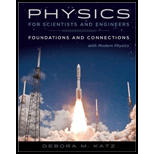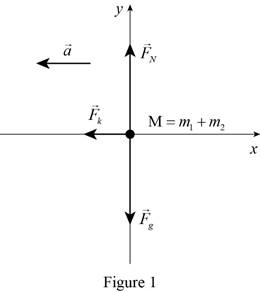
The velocity of the system just after the collision using Newton’s second law and the comparison of the answer with the result of Example 11.4.
Answer to Problem 32PQ
The velocity of the system just after the collision using Newton’s second law is
Explanation of Solution
The free-body diagram of the system is shown in figure 1.

The two-train system only moves in
Write the expression for the Newton’s second law in
Here,
Refer to figure 1. The only force acting in
Write the equation for
Here,
Put the above equation in equation (I).
The kinetic friction is proportional to the normal force and the normal force is in turn equal to the weight of the train.
Write the expression for
Here,
Write the equation for
Here,
Put the above equation in equation (III).
Put the above equation in equation (II) and rewrite it for
Initially only the freight train has momentum. Assume that the two trains move together with velocity
Here,
Rewrite the above equation for
Now consider the motion of the system just after the collision to the moment it comes to rest.
Replace
The speed of the two-train system as it comes to rest is zero.
Write the expression for the final speed of the system as it comes to rest.
Here,
Write the constant-acceleration equation of motion.
Here,
Put equations (IV) to (VI) in the above equation and rewrite it for
To find the range of possible initial freight train velocities, the extreme values of the coefficient of kinetic friction must be used.
Write the equation for
Here,
Conclusion:
Given that the value of
Substitute
Substitute
Here,
The system moves in
Here,
Substitute
Substitute
Here,
It is given that the train crosses the red signal at a speed of
Since the train passed the red signal with the speed of
Write the expression for the maximum velocity of the system.
Here,
Substitute
The range of the speed of the two-train system is
Therefore, the velocity of the system just after the collision using Newton’s second law is
Want to see more full solutions like this?
Chapter 11 Solutions
Physics For Scientists And Engineers: Foundations And Connections, Extended Version With Modern Physics
- Show that the units 1 v2/Q = 1 W, as implied by the equation P = V²/R. Starting with the equation P = V²/R, we can get an expression for a watt in terms of voltage and resistance. The units for voltage, V, are equivalent to [? v2 v2 A, are equivalent to J/C ✓ X . Therefore, 1 = 1 = 1 A V1 J/s Ω V-A X = 1 W. . The units for resistance, Q, are equivalent to ? The units for current,arrow_forwardPlease solve and answer the question correctly please. Thank you!!arrow_forwardPlease solve and answer the question correctly please. Thank you!!arrow_forward
- According to the provided information answer the question accorrding to grade 11 physics Jerry has decided to give up his part-time job for a new career, cat-burglar! Jerry loves the idea of dressing up like a cat all day and of course the chance of meeting Cat Woman! On Jerry's first "job" he figures out his escape plan. He travels 3.0 km south for 15 minutes and then 8.0 km west for 1.5 hours before reaching his house. Draw a sketch diagram of the path he took with all the appropriate labels.arrow_forwardPlease solve and answer all parts of the question correctly please. Thank you!!arrow_forwardPlease solve and answer this question correctly please. Thank you!!arrow_forward
 Physics for Scientists and Engineers: Foundations...PhysicsISBN:9781133939146Author:Katz, Debora M.Publisher:Cengage Learning
Physics for Scientists and Engineers: Foundations...PhysicsISBN:9781133939146Author:Katz, Debora M.Publisher:Cengage Learning Principles of Physics: A Calculus-Based TextPhysicsISBN:9781133104261Author:Raymond A. Serway, John W. JewettPublisher:Cengage Learning
Principles of Physics: A Calculus-Based TextPhysicsISBN:9781133104261Author:Raymond A. Serway, John W. JewettPublisher:Cengage Learning University Physics Volume 1PhysicsISBN:9781938168277Author:William Moebs, Samuel J. Ling, Jeff SannyPublisher:OpenStax - Rice University
University Physics Volume 1PhysicsISBN:9781938168277Author:William Moebs, Samuel J. Ling, Jeff SannyPublisher:OpenStax - Rice University Physics for Scientists and Engineers with Modern ...PhysicsISBN:9781337553292Author:Raymond A. Serway, John W. JewettPublisher:Cengage Learning
Physics for Scientists and Engineers with Modern ...PhysicsISBN:9781337553292Author:Raymond A. Serway, John W. JewettPublisher:Cengage Learning College PhysicsPhysicsISBN:9781938168000Author:Paul Peter Urone, Roger HinrichsPublisher:OpenStax College
College PhysicsPhysicsISBN:9781938168000Author:Paul Peter Urone, Roger HinrichsPublisher:OpenStax College Physics for Scientists and Engineers, Technology ...PhysicsISBN:9781305116399Author:Raymond A. Serway, John W. JewettPublisher:Cengage Learning
Physics for Scientists and Engineers, Technology ...PhysicsISBN:9781305116399Author:Raymond A. Serway, John W. JewettPublisher:Cengage Learning





